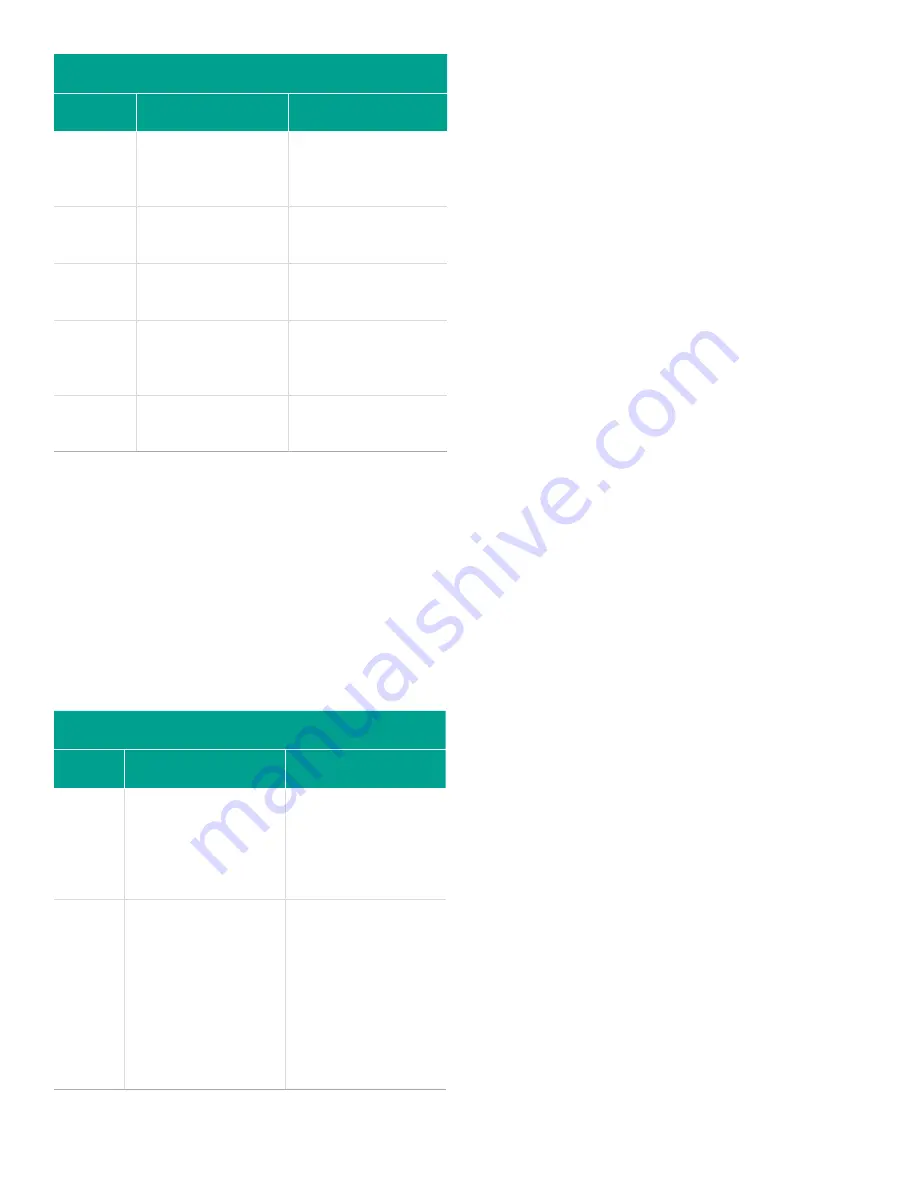
Table 7: Error response options
Option
Output response
Totalizer response
HOLD
Holds the last
“good” reading.
Continues to totalize,
based on last “good”
flow reading.
LOW
Forces outputs to
the low set point.
Stops totalizing.
HIGH
Forces outputs to
the high set point.
Stops totalizing.
HHIGH
Forces outputs
≈10% above the
high set point.
Stops totalizing.
OTHER
Forces outputs to
the entered mA level.
Stops totalizing during
critical errors.
6. Use the arrow keys to enter a specific current that will
signify meter errors and press [enter].
7. Scroll to
yes
or
no
to enable or disable 2-path error
handling. Specific responses of the display and the
totalizer are listed in
. The 2-path
error handling option is intended for applications where
two sets of transducers are installed in the same location
in the same pipe to improve accuracy and the meter
is operated in AVE mode. With this function enabled,
the model XGF868i performs error handling only if both
channels are in error. If this function is disabled, error
handling occurs when either channel goes into error.
Table 8: 2-Path error response options
Option
Display response
Totalizer response
No
Displays the average
of channel 1 and
channel 2, regardless
of the error state of
either channel.
Outputs the average
of channel 1 and
channel 2 totals,
regardless of the error
state of either channel.
Yes
1. If one channel is
in error, the other
channel’s value is
displayed as the
average.
2 If both channels
are in error, the last
average reading is
held.
1. If one channel is
in error, totalizing
continues.
2. If both channels are
in error, totalizing
stops.
Procedure options
After completing the above steps, the XGF868i returns to the
global I/O window. Do one of the following:
• To continue programming, refer to
, to navigate to the desired menu.
• To leave the
keypad program
, press [escape] four times.
1.9.2b Setting up slot 0 and slot 1 inputs/outputs
The XGF868i has two built-in analog outputs, which are
assigned to slot 0. Also, a variety of input/output option
cards may be installed in slot 1. See
Chapter 1, Installation
,
of the
Startup guide
for a complete description of the
available option cards.
To set up option cards, refer to one of the following sections:
• Analog outputs - see
• Analog inputs - see
• RTD - see
• Frequency outputs - see
1.9.2c Analog outputs
While following the programming instructions, refer to
.
Accessing the output
1. In the
keypad program
, scroll to
prog
and press [enter].
2. In the
prog
menu, scroll to
globl
and press [enter].
3. In the global
program
menu, scroll to I/O and press
[enter].
4. Scroll to
optn
and press [enter].
5. Scroll to slot 0 or slot 1, depending on which output you
want to set up.
6. Scroll to the desired
output
and press [enter].
NOTE:
Output letters (A, B, etc.) correspond to the output
wiring terminal numbers from top to bottom. For example,
output A corresponds to pins 1,2 and 3; output B corresponds
to pins 4, 5 and 6; etc.
Setting up the output scale
1. Scroll to the desired output scale and press [enter].
2. If you selected
off
, the XGF868i returns to the I/O window.
Go to
3. Scroll to the desired
channel
option (CH1, CH2, SUM, DIF
or AVE) and press [enter].
4. Scroll to the desired
measurement parameter
and press
[enter]. See
Table 9
below for a description of
the available options.
5. At zero, enter a value for the low end of the analog
output range and press [enter].
6. At full, enter a value for the high end of the analog
output range and press [enter].
14
Содержание DigitalFlow XGF868i
Страница 1: ...DigitalFlow XGF868i Panametrics flare gas flow transmitter Programming manual...
Страница 2: ...ii...
Страница 4: ...no content intended for this page iv...
Страница 10: ...x...
Страница 38: ...28...
Страница 46: ...no content intended for this page 36...
Страница 54: ...44...
Страница 60: ...50...
Страница 88: ...78...
Страница 94: ...84...






























